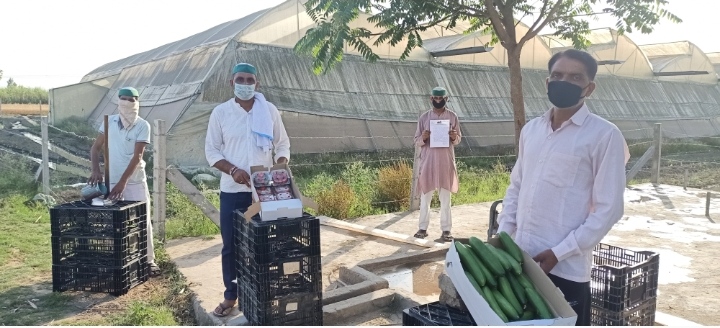
Farmers working during lockdown in Western Uttar Pradesh
Despite a 24-fold increase in testing, no rise in percentage of positive cases
Percentage of positive cases as a ratio of testing is more or less the same as that a month back.
Growth in number of cases has been more or less linear, not exponential: Chairman of Empowered Group 2
No fresh cases in 78 districts during the last 14 Days, no new case in 12 Districts during the last 28 days: Health Ministry
Stigma against COVID-19 patients is creating panic, due to which many are not coming out and seeking treatment, leading to higher morbidity and mortality: Director, AIIMS
-globalbihari bureau
New Delhi: During the 30 days of lockdown, Government has been able to cut transmission, minimize spread and increase the doubling time of COVID-19; consistently ramp up testing; and utilize time to prepare for the future.
Making a presentation on India’s strategy and preparedness in fighting COVID-19, Chairman of Empowered Group 2, C. K Mishra, who has been coordinating Availability of Hospitals, Isolation & Quarantine Facilities, Disease Surveillance & Testing and Critical Care Training he made the following points:
- One crucial weapon we employed during the 30-day lockdown period is RT-PCR testing. On March 23, 2020, we had done 14,915 tests, while on April 22, we had done more than 5 lakh tests. There has been an increase of around 33 times in 30 days.
- Post lockdown, while number of new positive COVID-19 cases has increased by 16 times, testing has increased by 24 times.
- The growth of COVID-19 cases has been more or less linear, not exponential; this indicates that the strategies we have adopted have succeeded in containing the infection to a particular level.
- Despite a 24-fold increase in testing, percentage of positive cases is not rising. Percentage of positive cases as a ratio of testing is more or less the same as that a month back.
- India has done better than majority of developed countries, with respect to the % of test cases yielding positive results. A comparative study, held after 400 cases were reached in India and other countries, show that India’s position is more advantageous than most other countries.
- The facts show that our testing strategy has been focused, targeted and continues to expand, this is an evolving strategy based on our learnings as we go along. As the challenge kept expanding, strategy too kept expanding.
- We expanded our testing base, mobilizing all possible resources – both public and private, and have decentralized the activities to manage it effectively.
- The lockdown period has been used gainfully to review, assess and expand our hospital infrastructure and preparedness; our effort has been to use resources and be over-prepared.
- Our first goal as regards hospitalization has been to ensure that the minimum no. of people need to come to hospital, using social distancing, discipline and taking care of the vulnerable such as the elderly and those with co-morbidities. The 2nd goal is to ensure enough infrastructure so that every person who needs to come to hospital is treated well, cured and sent back. Every district in the country is now working towards that.
- A 3-tier structure has been set up which will be employed to treat COVID-19 patients. No. of dedicated COVID Hospitals has increased by 3.5 times and no. of isolation beds by 3.6 times during the last one-month lockdown period. As per patient profile, the critical thing is oxygen, our entire hospital preparation is focused on ensuring oxygen support to those who need it. Our goal is to ensure that most people get cured at COVID Health Centre stage itself. We want to create a structure so that we test most people, treat them as per need and ensure we are able to cure them and save lives.
Director General, Indian Council of Medical Research, Balram Bhargava said that the nation’s philosophy has been more labs, more tests and more resources. “From NIV at the beginning of the year and around 100 labs at the beginning of lockdown, we have 325 laboratories testing for COVID-19 today,” he said adding that “Our strategy has been to detect the virus and then save lives. The entire scientific and medical community has risen to the occasion. Private sector too has energetically risen to the occasion.”
Bhargava said a supply chain for testing had now been created and the Centre had been working with states to ensure required reagents were supplied to testing labs in timely and calibrated fashion, enabling diversion of reagents to hot spots as needed. “We have also decentralized the supply chain and created 15 hubs to which materials are supplied and further distributed. The gold standard for COVID-19 testing remains and has remained the RT-PCR test, which detects the virus and thereby enables us to save lives. This has been our principle and strategy for testing,” he said.
Prof. Randeep Guleria, Director, All India Institute of Medical Sciences, New Delhi, said that the societal stigma attached with COVID-19 patients was leading many people to not come forward and get tested or treated, “leading not only to huge mental agonies and problems but also higher morbidity and mortality”. He lamented that instead of sympathising with the patients and their family, an environment of fear and panic had been created. “Patients are facing a lot of challenges and stigma which is not justified. Recovered patients are symbols of victory, but we have stigmatized them, causing a huge problem. Due to the stigma we have attached, patients are not coming forward, they are coming very late when they have severe breathlessness issues, thereby increasing morbidity and mortality,’ he pointed out. He said many of these COVID-19 patients can be saved by just giving them oxygen. “If they do not get oxygen, it can trigger various other problems. Our strategy of expanding oxygen support is based on this.” He said that there was a need to reach out to those patients who were afraid to come out because of stigma and thereby posing a danger to their lives. “We should look at how we can support people and families who have COVID-19 and encourage people to come forward,” he said
Prof. Guleria informed that the primary treatment for COVID-19 was supportive in more than 80% of patients, oxygen therapy in 15% of patients, with other drugs such as convalescent plasma. HCQ and other repurposed drugs, and newer drugs were being looked at, he said adding that “there is hope as far as treatment is concerned”.






Thanks, this news break is very informative and reassuring. AIIMS Director views are also quite meaningful. Keep updating us in these testing times.
Mihir Bholey
Ahmedabad